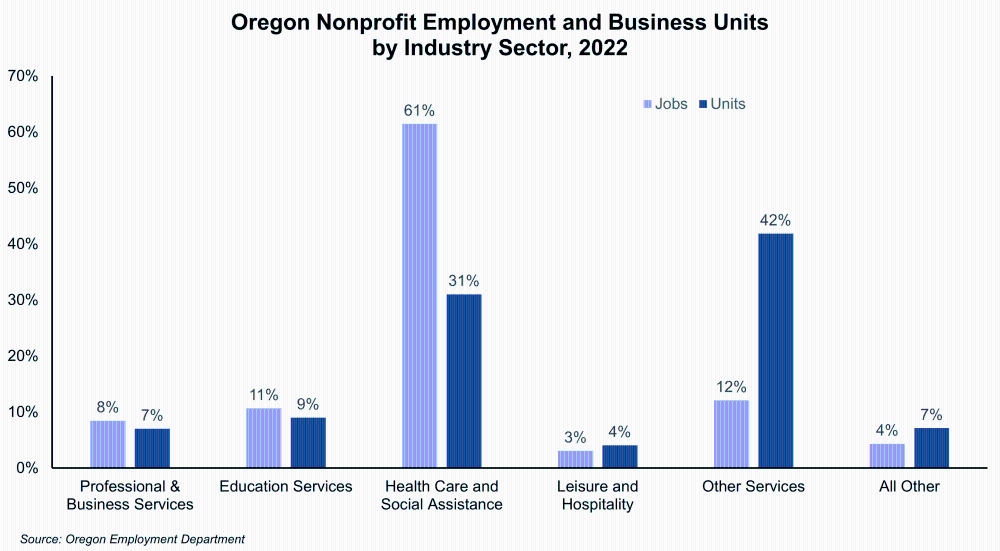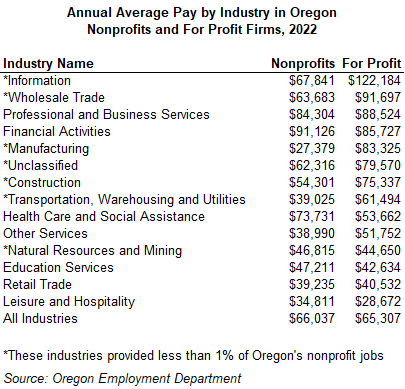Oregon's Nonprofits in 2022
November 17, 2023A not-for-profit corporation, commonly referred to as a "nonprofit," is organized to achieve a purpose other than to generate a profit. These entities qualify for federal tax exempt status and must reinvest any surplus revenues into efforts that further the mission of the organization. They are prohibited from passing profits on to those who control the organization. These organizations range from trade unions and religious groups to food banks and private schools. Many hospitals are also organized as nonprofit corporations.
For the purposes of this article, the impact of nonprofits presented is limited to employment and wages.
Oregon's 2022 nonprofit stats:
- 10,000 nonprofit establishments with employment and payroll
- 189,300 nonprofit jobs
- 42% of all nonprofits were in the other services industry
- 61% of nonprofit employment was in health care and social assistance
- $66,037 in annual average pay
- $28.01 median hourly wage (third quarter 2021)
- 10% of nonprofit jobs paid under $15.00 per hour (third quarter 2021)
- Most nonprofit jobs – 73% – paid $20.00 or more per hour (third quarter 2021)
Keep in mind that not all nonprofit organizations are employers, and thus are not included in the employment and wage data presented here. Nonprofits in Oregon must file articles of incorporation with the Secretary of State’s office, while the Department of Justice regulates charitable activities.
The Secretary of State’s office provides a searchable database of active nonprofit corporations, available at this URL:
https://data.oregon.gov/Business/Active-Nonprofit-Corporations/8kyv-b2kw
Likewise, the Department of Justice has a searchable database for Oregon charities, here:
https://www.doj.state.or.us/charitable-activities/
How Many Nonprofit Employers Are There in Oregon?
Nonprofit organizations played an integral role in Oregon's economy. They made up 6% of all private businesses in the state and had 189,300 jobs, accounting for 11% of Oregon's private-sector employment. As a share of Oregon's total (private and public) employment, nonprofits made up 10% in 2022, about the same amount as the state’s manufacturing industry.
Nonprofits by Industry
Health care and social assistance dominated Oregon’s nonprofit employment in 2022, representing 116,300 jobs or 61%. Other services included 22,900 nonprofit jobs and educational services employed 20,200. Together, the top three industries represented 84% of Oregon’s total nonprofit employment.

Nonprofit Hospitals: Health Care and Social Assistance
Health care and social assistance led nonprofits with 116,300 jobs or 61% of Oregon's nonprofit employment. Like other services, there is diversity in the industry from assisted living facilities to mental health services. However, hospitals completely overshadow the sector’s employment. Oregon’s nonprofit hospitals (general medical and surgical; psychiatric and substance abuse; and specialty) included 80 reporting units in 2022 and employed 55,300, or 48% of the nonprofit health care and social assistance industry's total employment. Hospitals in Oregon (government and private) included 126 reporting units and provided 66,200 jobs in 2022, with nonprofit hospitals representing 84% of the employment.
Service Organizations
Other services represented about 12% of the state's nonprofit employment (22,900 jobs). The correlation between other services and nonprofits makes sense. It is the industry that includes religious, grant making, civic, professional, and similar organizations. Places of worship, the Boys & Girls Club, The United Way, and local chambers of commerce are some of the most widely recognized nonprofits in Oregon, and there are a lot of these organizations across the state. Other services accounted for 41% of Oregon's nonprofit organizations (4,200).
Educational and Employment Training Providers
Educational services accounted for 11% of Oregon's nonprofit employment in 2022 with 20,200 jobs. The organizations in this industry range from preschools and tutoring services to colleges and employment training places. Nonprofit elementary and secondary schools represented the biggest slice with 10,200 jobs (51%) and 337 reporting units (37%). Nonprofit colleges, universities, and professional schools accounted for 8,000 jobs (40%) while representing 23% of the nonprofit educational services provider reporting units. Other schools and instruction, including sports training, provided 1,200 jobs (6%), and 19% of nonprofit educational services reporting units.
Pay at Nonprofits Follows Industry Standards
Oregon's private for-profit industries paid an average annual wage of $65,307 in 2022, compared with $66,037 for nonprofits. Although the average wage gap between for-profit and nonprofit employers was just $700 (1.1%) in 2022, their industry profiles were quite different.

In 2022, six industry sectors reported higher annual average wages for nonprofits compared with for-profit businesses. Nonprofits in financial activities paid an average $91,126 in 2022, which exceeded for-profit pay by about $5,400 or 6%. Leisure and hospitality also favored nonprofits by $6,139 (+21%), despite having a relatively low annual average pay at $34,811.
Health care and social assistance, Oregon’s largest nonprofit industry, enjoyed a pay advantage of nearly $20,100 or 37% over for-profit employers, paying an average $73,731 in 2022. Other services paid $38,990 in 2022, falling about $12,800 or 25% below for-profit employers. Educational services paid an average $47,211 in 2022, exceeding for-profit pay by about $4,600 or 11%.
Rural Versus Urban
Oregon's 23 nonmetro counties provided a home base for 1,700 nonprofit employer units in 2022 or 7% of all nonmetro private industry employer reporting units. Nonprofit organizations provided about 22,900 rural Oregon jobs, or 11% of all nonmetro private employment. Rural nonprofit pay averaged $57,234 in 2022, which exceeded the average for all private industries by 22%, around $10,100.
In Oregon’s metropolitan areas, nonprofits provided close to 166,400 jobs in 2022, or 11% of all metro private employment. With about 8,300 employer units, metros provided a home base for 83% of Oregon nonprofits, and nonprofits represented 5% of all metro private employer units. In 2022, nonprofit pay averaged $67,250 in metro Oregon, falling 1% (about $700) below the all private industries average.
Only four rural counties provided more than 1% of Oregon’s nonprofit jobs in 2022. Douglas County led rural Oregon with 3,600 nonprofit jobs, or 1.9% of Oregon’s total, followed by Klamath County (1.6%), Umatilla County (1.3%), and Wasco County (1.0%). Metropolitan areas commanded 88% of Oregon’s nonprofit employment led by Multnomah County’s 33% (about 61,700 jobs). Together with Washington County (10.7%) and Lane County (8.2%), Oregon’s top three metro counties represented 51% of all nonprofit jobs in 2022.
The Future of Nonprofit Employment
The future of nonprofit employment in Oregon is directly linked to growth in health care and social assistance. The industry provided 268,100 jobs in 2022, an increase of about 32% or 65,000 since 2012, including the reclassification of home care workers from state government in 2018. With 61% of Oregon’s nonprofit employment in 2022, health care and social assistance will continue to lead its job growth. Health care and social assistance represented an even larger share of rural Oregon’s nonprofit employment and payroll. The industry provided 72% of rural Oregon’s 22,900 nonprofit jobs along with 84% of its $1.3 billion payroll.